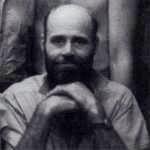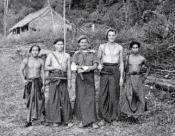
|
The King's School Canterbury |
Roll of Honour |
| Major Francis George Leach CHESTER (89027) DSO OBE | |
|
General List attached to Z Special Unit, Special Operations Executive Australia Date of birth: 14th June 1899 Date of death: 18th August 1946 Died aged 47 Buried the Anglican Cemetery, Kota Kinabalu, Malaysia |

|
| He was born at Johannesburg, South Africa on the 14th of June 1899 the son of Arthur Chester, electrical engineer, and Edith Florence Rose (nee Murphy) of Knysna, Cape Province, South Africa. He was educated at Highfield School, Liphook, Hampshire and at the King's School Canterbury from May 1914 to July 1916. He went on to the Military College Sandhurst from where he was commissioned as a 2nd Lieutenant in King Edward's Horse. He served in France from 1917 and was demobilised at the end of the war. He was known as "Pug", or "Gort" due to his resemblance to Field Marshall Gort VC. In 1923 he left for Borneo where he worked for the Borneo Manilla and Hemp Company before becoming a rubber planter at the Lokawee Estate near Jesselton on the west coast of North Borneo. In 1941 he left Borneo to join the army and was commissioned as an officer in the King's African Rifles and saw action with them in Abyssinia. By the outbreak of war in the Far East he was in Australia and in 1942 he was approached by the Indian Branch of the Special Operations Executive and was commissioned as a 2nd Lieutenant on the General List on the 1st of May 1942, but was not paid from army funds. From the 1st of May 1942 to the 20th of September 1943 he served in operations along the Burmese border. He was fluent in Malay and Dusan and was trained in sabotage and propaganda. He was promoted to Captain on the 1st of June 1942 and to Major on the 7th of September 1943. In September 1943 he was attached to Z Special Unit of the Australian Army Services Reconnaissance Department and was given command of their first operation, Operation Python I in October 1943. The unit was charged with gathering intelligence, making contact with the native population, preparing drop zones for supplies and organising guerrillas. They landed at Labian Point in North Borneo, opposite the Tawi-Tawi Islands. The operation reported on Japanese shipping movements in the Sibutu Passage and Balabec Strait of the Sulu Sea to the north of North Borneo and also provided support to a band of Filipino guerrillas under Captain Jordan A. Hamner of the US Army. After he had been there a short time he requested 5,000lbs of stores, arms and medicines to be landed but was supplied instead with 7,000lbs of mostly useless equipment which forced him to cancel an extended reconnaissance which he had planned of the western coast of Borneo. A new landing of supplies was planned which was to be landed by submarine but, in Chester's opinion, the area chosen for the landing was totally unsuitable and he protested. He was threatened with being relieved unless he complied and so he arranged for a small party of five men to travel by boat to meet the submarine. When the men arrived at the rendezvous they were driven off by Japanese troops. A further attempt to rendezvous with Chester's men was arranged by the submarine, but it came under attack and was forced to submerge, managing to take one of the pickup party of five aboard before submerging. The other four men were captured or killed. He was extracted from Borneo on the 24th of June 1944 and returned to Australia from where he sailed to England to report on his mission, arriving there on the 10th of November 1944. He left England, bound for Melbourne on the 25th of November 1944. He was recommended for the Distinguished Service Order after this operation by the Australian Prime Minister, in a letter dated the 19th of October 1944 to the Dominions Office in London - "In recognitions of services rendered in highly dangerous operations in enemy held territory and while abroad with the S.A.O Party "Python"." A response was sent from the War Office by telegram on the 9th of December 1944 and contained the following: - "War Office observe that it does not appear from report that party ever came under enemy fire. While valuable services rendered are nevertheless fully appreciated it is not considered that gallantry decorations and medals would be appropriate form of recognition. Following proposals would in War Office opinion be suitable and I should be glad if they could receive consideration and if I could be informed whether you and your Prime Minister would desire them to be substituted. O.B.E Chester M.B.E. Woods and Chew B.E.M. Olsen." He was awarded the Order of the British Empire for 'gallant and distinguished service in the field' on the 8th of March 1945 which was announced in the London Gazette of the 26th of April 1945. In early March 1945, he was given command of Operation AGAS 1, a party consisting of three other officers and three NCOs, which landed near Lanuk Bay in North Borneo by submarine on the 3rd of March. When they landed they came across posters of Chester offering a bounty of $15,000 for his capture, dead or alive. The natives in the area were hostile towards allied troops which meant the group had to travel some 250 miles by canoe before being able to move inland to begin their mission. They were to gather intelligence on Japanese forces in the area, form a native guerrilla force and persuade the natives not to provide the Japanese with food and other support. The intelligence gathered during this operation resulted in the destruction by air action of six hundred Japanese troops in the Sandakan area, one hundred in the Beluran area and one hundred and fifty in the Langkon area. Large areas of the country were cleared of the Japanese by guerrilla groups which had been organised by the party and three escaped prisoners of war were brought back to Australia. He was promoted to Lieutenant Colonel on the 6th of May 1945. On the 25th of May 1945 Chester was picked up by a Catalina flying boat in order to brief the staff of II Corps. He returned to Borneo on the 29th of May along with some additional personnel to command Operation AGAS III, an effort to obtain further information for the 9th Australian Division. This small unit operated in the Jesselton-Keningau-Beaufort areas of North Borneo. The mission incorporated Operation Stallion IV which aimed to obtain information on Japanese movements along the North Borneo Railway, the Ranu-Tambunan-Keningau Road and in the hinterland of Kimanis Bay. For these operations he was awarded the Distinguished Service Order which appeared in the London Gazette of the 6th of March 1947. The recommendation for his award reads as follows: - "From 3 Mar 45 to 15 Aug 45 this officer displayed leadership, gallantry and cold blooded courage of the highest order. On 3 Mar 45 this officer leading a small party of 3 officers and 3 NCOs re-entered British North Borneo, well knowing: - (a) That there was a large price on his head as a result of his previous mission into the area. (Enemy posters were found bearing his portrait and offering a reward of 15,000 dollars for him, dead or alive. (b) That having left the submarine there was no chance of withdrawal. (c) That the coast was strongly held by the enemy and continuously patrolled by land and sea. The landing was made midway between two strong enemy posts at Tegahang and Pura Pura 3 miles apart. Owing to the hostility of the native Lt Col. Chester travelled 250 miles by canoe at night before finding a friendly contact enabling him to lead his party inland. Once inland Lt Col. Chester established his HQ from which he successfully: (a) Obtained military intelligence for future operations. (b) Raised a guerrilla force amongst the local inhabitants to harass the enemy and destroy his resources. (c) Organised the native population to deny the enemy essential native food and labour. (d) Spread pro-allied propaganda thus ensuring a friendly and co-operative people to welcome the Allies when the time for invasion of the country came. On 21 May 45 this officer was extracted by Catalina for interrogation by 3 Aust. Corps and when further information was required on behalf of 9 Aust. Div he volunteered to re-enter Borneo for the third time. On 29 May 45 with 2 ORs and a native, Lt Col. Chester was inserted by Catalina into the strongly held Beaufort area near Brunei Bay. After a reconnaissance of the situation on 31 May 45, this officer discovered that the railway stationmaster at Bongawan was a Chinese named An Lek, known to him in pre war days. In a particularly daring operation, said stationmaster was extracted in broad daylight from the station, which was staffed and guarded by Japanese, and liberated by this officer. During the next 8 days, this officer checked the information passed by An Lek and at great personal risk, watched hundreds of Japanese moving down the railway line to Beaufort. The intelligence thus obtained and passed on was of the highest importance to 9 Aust. Div and subsequently his estimate of strength was proved accurate. From 29 May 45 to 7 Jun. 45 this small party operated in the heart of the most, strongly held area in British North Borneo, necessarily on the alert 24 (twenty four) hours of the day. On 7 Jun 45 Lt Col Chester and his party were extracted by Catalina and a few weeks later returned to his HQ in the interior where he continued his work so successfully that, at the time of the enemy surrender, two thirds of British North Borneo was under his control." At the end of the war he went briefly to Australia before returning to Borneo on the 18th of October 1945 on board the SS Dominion Monarch. He resigned his commission on the 30th of March 1946 and died from black water fever at Jesselton. Colonel J. Findlay of the Headquarters of the Australian Services Reconnaissance Department said of him: - "He could cut his way though close jungle quicker than almost any man alive" - but that he'd never known him to walk more than 100 yards in Melbourne without hailing a cab. He is not currently commemorated on the war memorial at the King's School Canterbury. |
|
 | |
Back